[English] 日本語
 Yorodumi
Yorodumi- EMDB-23099: Structure of NTS-NTSR1-Gi complex in lipid nanodisc, canonical st... -
+ Open data
Open data
- Basic information
Basic information
| Entry | Database: EMDB / ID: EMD-23099 | |||||||||
|---|---|---|---|---|---|---|---|---|---|---|
| Title | Structure of NTS-NTSR1-Gi complex in lipid nanodisc, canonical state, AHD and nanodisc mask out | |||||||||
 Map data Map data | ||||||||||
 Sample Sample |
| |||||||||
 Keywords Keywords | GPCR / NTSR1 / NTS / G protein / Nanodisc / SIGNALING PROTEIN | |||||||||
| Function / homology |  Function and homology information Function and homology informationregulation of locomotion involved in locomotory behavior / Peptide ligand-binding receptors / positive regulation of locomotion / neuropeptide receptor binding / G protein-coupled neurotensin receptor activity / regulation of inositol trisphosphate biosynthetic process / inositol phosphate catabolic process / symmetric synapse / D-aspartate import across plasma membrane / positive regulation of gamma-aminobutyric acid secretion ...regulation of locomotion involved in locomotory behavior / Peptide ligand-binding receptors / positive regulation of locomotion / neuropeptide receptor binding / G protein-coupled neurotensin receptor activity / regulation of inositol trisphosphate biosynthetic process / inositol phosphate catabolic process / symmetric synapse / D-aspartate import across plasma membrane / positive regulation of gamma-aminobutyric acid secretion / eye photoreceptor cell development / regulation of membrane depolarization / positive regulation of arachidonate secretion / vocalization behavior / response to antipsychotic drug / neuron spine / L-glutamate import across plasma membrane / regulation of behavioral fear response / neuropeptide hormone activity / regulation of respiratory gaseous exchange / cAMP biosynthetic process / positive regulation of inhibitory postsynaptic potential / negative regulation of systemic arterial blood pressure / negative regulation of release of sequestered calcium ion into cytosol / G alpha (q) signalling events / hyperosmotic response / digestive tract development / positive regulation of glutamate secretion / response to mineralocorticoid / response to food / response to corticosterone / cellular response to lithium ion / temperature homeostasis / response to lipid / positive regulation of inositol phosphate biosynthetic process / detection of temperature stimulus involved in sensory perception of pain / response to stress / associative learning / conditioned place preference / phototransduction / cellular response to dexamethasone stimulus / neuropeptide signaling pathway / response to axon injury / adenylate cyclase inhibitor activity / transport vesicle / positive regulation of protein localization to cell cortex / T cell migration / Adenylate cyclase inhibitory pathway / D2 dopamine receptor binding / response to prostaglandin E / cardiac muscle cell apoptotic process / axon terminus / photoreceptor inner segment / adenylate cyclase regulator activity / G protein-coupled serotonin receptor binding / adenylate cyclase-inhibiting serotonin receptor signaling pathway / cellular response to forskolin / regulation of mitotic spindle organization / response to amphetamine / positive regulation of release of sequestered calcium ion into cytosol / blood vessel diameter maintenance / dendritic shaft / adult locomotory behavior / learning / response to cocaine / Regulation of insulin secretion / liver development / positive regulation of cholesterol biosynthetic process / negative regulation of insulin secretion / cellular response to nerve growth factor stimulus / G protein-coupled receptor binding / response to peptide hormone / adenylate cyclase-inhibiting G protein-coupled receptor signaling pathway / visual learning / cytoplasmic side of plasma membrane / adenylate cyclase-modulating G protein-coupled receptor signaling pathway / centriolar satellite / G-protein beta/gamma-subunit complex binding / Olfactory Signaling Pathway / Activation of the phototransduction cascade / terminal bouton / G beta:gamma signalling through PLC beta / Presynaptic function of Kainate receptors / Thromboxane signalling through TP receptor / G protein-coupled acetylcholine receptor signaling pathway / Activation of G protein gated Potassium channels / Inhibition of voltage gated Ca2+ channels via Gbeta/gamma subunits / G-protein activation / Prostacyclin signalling through prostacyclin receptor / G beta:gamma signalling through CDC42 / Glucagon signaling in metabolic regulation / G beta:gamma signalling through BTK / Synthesis, secretion, and inactivation of Glucagon-like Peptide-1 (GLP-1) / ADP signalling through P2Y purinoceptor 12 / photoreceptor disc membrane / Sensory perception of sweet, bitter, and umami (glutamate) taste / Glucagon-type ligand receptors / Adrenaline,noradrenaline inhibits insulin secretion / GDP binding / Vasopressin regulates renal water homeostasis via Aquaporins Similarity search - Function | |||||||||
| Biological species |   Homo sapiens (human) Homo sapiens (human) | |||||||||
| Method | single particle reconstruction / cryo EM / Resolution: 4.1 Å | |||||||||
 Authors Authors | Zhang M / Gui M | |||||||||
 Citation Citation |  Journal: Nat Struct Mol Biol / Year: 2021 Journal: Nat Struct Mol Biol / Year: 2021Title: Cryo-EM structure of an activated GPCR-G protein complex in lipid nanodiscs. Authors: Meng Zhang / Miao Gui / Zi-Fu Wang / Christoph Gorgulla / James J Yu / Hao Wu / Zhen-Yu J Sun / Christoph Klenk / Lisa Merklinger / Lena Morstein / Franz Hagn / Andreas Plückthun / Alan ...Authors: Meng Zhang / Miao Gui / Zi-Fu Wang / Christoph Gorgulla / James J Yu / Hao Wu / Zhen-Yu J Sun / Christoph Klenk / Lisa Merklinger / Lena Morstein / Franz Hagn / Andreas Plückthun / Alan Brown / Mahmoud L Nasr / Gerhard Wagner /    Abstract: G-protein-coupled receptors (GPCRs) are the largest superfamily of transmembrane proteins and the targets of over 30% of currently marketed pharmaceuticals. Although several structures have been ...G-protein-coupled receptors (GPCRs) are the largest superfamily of transmembrane proteins and the targets of over 30% of currently marketed pharmaceuticals. Although several structures have been solved for GPCR-G protein complexes, few are in a lipid membrane environment. Here, we report cryo-EM structures of complexes of neurotensin, neurotensin receptor 1 and Gαβγ in two conformational states, resolved to resolutions of 4.1 and 4.2 Å. The structures, determined in a lipid bilayer without any stabilizing antibodies or nanobodies, reveal an extended network of protein-protein interactions at the GPCR-G protein interface as compared to structures obtained in detergent micelles. The findings show that the lipid membrane modulates the structure and dynamics of complex formation and provide a molecular explanation for the stronger interaction between GPCRs and G proteins in lipid bilayers. We propose an allosteric mechanism for GDP release, providing new insights into the activation of G proteins for downstream signaling. | |||||||||
| History |
|
- Structure visualization
Structure visualization
| Movie |
 Movie viewer Movie viewer |
|---|---|
| Structure viewer | EM map:  SurfView SurfView Molmil Molmil Jmol/JSmol Jmol/JSmol |
| Supplemental images |
- Downloads & links
Downloads & links
-EMDB archive
| Map data |  emd_23099.map.gz emd_23099.map.gz | 59.7 MB |  EMDB map data format EMDB map data format | |
|---|---|---|---|---|
| Header (meta data) |  emd-23099-v30.xml emd-23099-v30.xml emd-23099.xml emd-23099.xml | 22.3 KB 22.3 KB | Display Display |  EMDB header EMDB header |
| FSC (resolution estimation) |  emd_23099_fsc.xml emd_23099_fsc.xml | 9.2 KB | Display |  FSC data file FSC data file |
| Images |  emd_23099.png emd_23099.png | 121.3 KB | ||
| Masks |  emd_23099_msk_1.map emd_23099_msk_1.map | 64 MB |  Mask map Mask map | |
| Filedesc metadata |  emd-23099.cif.gz emd-23099.cif.gz | 6.5 KB | ||
| Others |  emd_23099_half_map_1.map.gz emd_23099_half_map_1.map.gz emd_23099_half_map_2.map.gz emd_23099_half_map_2.map.gz | 49.9 MB 49.7 MB | ||
| Archive directory |  http://ftp.pdbj.org/pub/emdb/structures/EMD-23099 http://ftp.pdbj.org/pub/emdb/structures/EMD-23099 ftp://ftp.pdbj.org/pub/emdb/structures/EMD-23099 ftp://ftp.pdbj.org/pub/emdb/structures/EMD-23099 | HTTPS FTP |
-Related structure data
| Related structure data |  7l0pMC  7l0qC  7l0rC  7l0sC M: atomic model generated by this map C: citing same article ( |
|---|---|
| Similar structure data |
- Links
Links
| EMDB pages |  EMDB (EBI/PDBe) / EMDB (EBI/PDBe) /  EMDataResource EMDataResource |
|---|---|
| Related items in Molecule of the Month |
- Map
Map
| File |  Download / File: emd_23099.map.gz / Format: CCP4 / Size: 64 MB / Type: IMAGE STORED AS FLOATING POINT NUMBER (4 BYTES) Download / File: emd_23099.map.gz / Format: CCP4 / Size: 64 MB / Type: IMAGE STORED AS FLOATING POINT NUMBER (4 BYTES) | ||||||||||||||||||||||||||||||||||||||||||||||||||||||||||||
|---|---|---|---|---|---|---|---|---|---|---|---|---|---|---|---|---|---|---|---|---|---|---|---|---|---|---|---|---|---|---|---|---|---|---|---|---|---|---|---|---|---|---|---|---|---|---|---|---|---|---|---|---|---|---|---|---|---|---|---|---|---|
| Projections & slices | Image control
Images are generated by Spider. | ||||||||||||||||||||||||||||||||||||||||||||||||||||||||||||
| Voxel size | X=Y=Z: 0.825 Å | ||||||||||||||||||||||||||||||||||||||||||||||||||||||||||||
| Density |
| ||||||||||||||||||||||||||||||||||||||||||||||||||||||||||||
| Symmetry | Space group: 1 | ||||||||||||||||||||||||||||||||||||||||||||||||||||||||||||
| Details | EMDB XML:
CCP4 map header:
| ||||||||||||||||||||||||||||||||||||||||||||||||||||||||||||
-Supplemental data
-Mask #1
| File |  emd_23099_msk_1.map emd_23099_msk_1.map | ||||||||||||
|---|---|---|---|---|---|---|---|---|---|---|---|---|---|
| Projections & Slices |
| ||||||||||||
| Density Histograms |
-Half map: #2
| File | emd_23099_half_map_1.map | ||||||||||||
|---|---|---|---|---|---|---|---|---|---|---|---|---|---|
| Projections & Slices |
| ||||||||||||
| Density Histograms |
-Half map: #1
| File | emd_23099_half_map_2.map | ||||||||||||
|---|---|---|---|---|---|---|---|---|---|---|---|---|---|
| Projections & Slices |
| ||||||||||||
| Density Histograms |
- Sample components
Sample components
+Entire : NTS-NTSR1-Gi complex in lipid nanodisc
+Supramolecule #1: NTS-NTSR1-Gi complex in lipid nanodisc
+Supramolecule #2: NTSR1
+Supramolecule #3: NTS
+Supramolecule #4: G(i) subunit alpha-1
+Supramolecule #5: G(I)/G(S)/G(T) subunit beta-1
+Supramolecule #6: G(T) subunit gamma-1
+Macromolecule #1: Neurotensin receptor type 1
+Macromolecule #2: Neurotensin
+Macromolecule #3: Guanine nucleotide-binding protein G(i) subunit alpha-1
+Macromolecule #4: Guanine nucleotide-binding protein G(I)/G(S)/G(T) subunit beta-1
+Macromolecule #5: Guanine nucleotide-binding protein G(T) subunit gamma-T1
-Experimental details
-Structure determination
| Method | cryo EM |
|---|---|
 Processing Processing | single particle reconstruction |
| Aggregation state | particle |
- Sample preparation
Sample preparation
| Buffer | pH: 6.9 |
|---|---|
| Grid | Material: COPPER / Pretreatment - Type: GLOW DISCHARGE |
| Vitrification | Cryogen name: ETHANE |
- Electron microscopy
Electron microscopy
| Microscope | FEI TITAN KRIOS |
|---|---|
| Image recording | Film or detector model: GATAN K3 BIOQUANTUM (6k x 4k) / Average electron dose: 57.0 e/Å2 |
| Electron beam | Acceleration voltage: 300 kV / Electron source:  FIELD EMISSION GUN FIELD EMISSION GUN |
| Electron optics | Illumination mode: FLOOD BEAM / Imaging mode: BRIGHT FIELD |
| Experimental equipment |  Model: Titan Krios / Image courtesy: FEI Company |
+ Image processing
Image processing
-Atomic model buiding 1
| Refinement | Space: REAL / Protocol: FLEXIBLE FIT |
|---|---|
| Output model |  PDB-7l0p: |
 Movie
Movie Controller
Controller


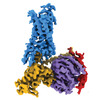



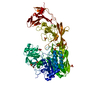
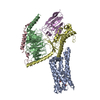

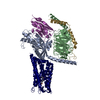

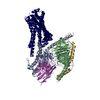

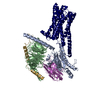

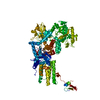




























 Z (Sec.)
Z (Sec.) Y (Row.)
Y (Row.) X (Col.)
X (Col.)

















































